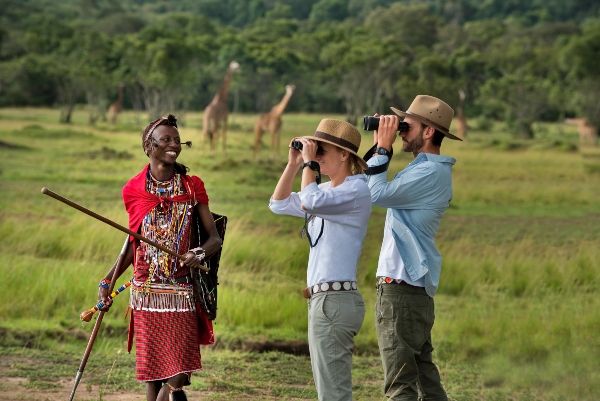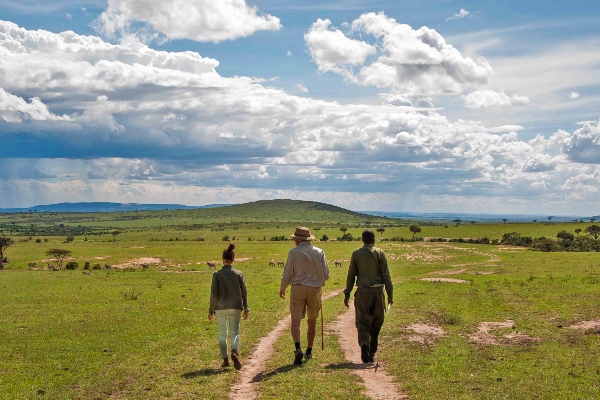Walking safaris in Nyerere National Park : One of the top safari locations in Tanzania’s southern region is Nyerere National Park. The National Park, formerly the Selous Game Reserve, is home to a wide variety of animal and bird species, each of which can be found in its natural environment throughout the park. The Nyerere National Park can be explored in a number of ways, and game reserves are one of them.

Walking safaris in Nyerere National Park
The best method for visitors to see Tanzania wildlife and its untamed side and is through walking safaris. Walking safaris is one of the major activities to enjoy while on Tanzania safari tours to Nyerere National Park. A walking safari, sometimes known as a bush walk, is a Tanzania safari experience in which visitors take a guided stroll around the park with the primary goal of getting up close and personal with the animals and birds without the use of cars. There are two ways in which walking safaris are done in Nyerere National Park.
There are walking safaris that take place inside the National Park which are done in the mornings and end in the late afternoons. It will take 45 minutes to an hour to stroll through the park, during which you can witness the flora and wildlife. The approximate cost of a guided walk in the National Park is between $50 and $80 per person.
These nature walks take place on designated walkways, and with the assistance of the tour guide, you will stay on the clearly marked trails to keep safe from approaching potentially dangerous creatures up close. An armed ranger will be given for additional protection, even though safety measures are implemented with regard to the walking paths. On your nature walk, you may observe a variety of creatures, including antelopes, crocodiles, elephants, and zebras.
When compared to walking safaris conducted inside the Park, those conducted outside the Reserve typically last far longer. You will travel 9 to 15 kilometres each person which should take 2 to 3 hours. You can choose from a variety of paths for your walk, and a tour guide can help you cross the distance while sharing a wealth of knowledge about the National Park.
This walk costs between $90 to $150 per person, and it’s best done in the early morning and late afternoon when the sun isn’t too strong. A prearranged picnic location will provide a packed lunch, and during the stroll, you’ll be able to take in sights of the surrounding lush vegetation, wildlife, and parks.
The Best time for walking safaris in Nyerere National Park
In Nyerere National Park, June through October is the finest time of year for a walking safari during the dry season. This is because, in contrast to the rainy season, when the routes are primarily inundated, the walk routes are easily navigable and not flooded during the dry season.
What is a game drive?
A game drive is a safari into a wildlife area in a vehicle, such as a national park or game reserve. This activity involves exploring National Parks and Game Reserves to witness the variety of wildlife, or the animals and birds that reside there in their natural habitat, is the primary goal of a game dive. A safari is different from a wildlife drive in that it involves more than just driving through the park; on the other hand, a safari offers several methods of experiencing the national park.
Game drives in Nyerere National Park
The game drives in Nyerere take two to three hours each and are conducted in the morning and afternoon. Nyerere National Park only offers day trips and does not provide night game drives like other national parks in the nation.
Morning Game drives
The start time of the morning drive is often 6:30 am or 8:00 am, depending on your schedule. Visitors can view the morning movements of the park’s animals and bird species by taking this trip.
Afternoon Game drives
When the sun starts to set at approximately 3:00 pm, right after lunch, the afternoon drive begins. Usually, this is carried out near the banks of the Rufiji River, where it is easy to observe the majority of the creatures.
Vehicles used during game drives
Tour operators in Tanzania utilise many vehicle types to transport guests to Nyerere; however, two often employed varieties are 4×4 jeeps and minibuses, which are primarily used for large group tours. Due to the dusty and uneven roads leading to the park, which are particularly rough and dusty in the dry season and treacherous in the rain, 4×4 open-sided vehicles are mostly only allowed to be driven inside the National Park and not on the highway.

4×4 jeeps
In Tanzania, the most popular vehicles utilised by tour operators are 4×4 safari jeeps. It can accommodate up to 6 people if an additional seat is fitted to the car, while its typical capacity is only 5 people. The vehicles are very accommodating and comfortable for the rough roads in the Park, giving visitors a great view of the wildlife. Included in the safari package are the open roof shield jeeps, which you may use to travel the entire distance from Dar es Salaam. If you prefer to drive, you can rent a car from a number of reliable agencies.
Open sided 4×4 vehicles
A Safari on the open side 4×4 vehicles are permitted inside the only in the National Park; using them on roadways is not advised. These cars, which are common in most camps are meant to take you on game drives into the National Park, where you can get up-close looks at various animal and bird species.
Vans and mini vans
The best method to get to Nyerere is by minivan, especially if you’re on a tight budget. Unlike open jeeps, these may accommodate up to nine visitors and are advised for highway travel to Nyerere. Although they are not 4×4 cars, they are nevertheless suitable for travel, albeit it is not a good idea to use them on slick roads during the rainy season. The benefits of using minivans include its affordability, dependability, comfort, and ease of use in getting you where you need to go.
The best time for game drives
The dry season, which runs from June to October, is the ideal time of year to go on a game drive in Nyerere. This is the greatest time to see creatures such the Greater Kudu, zebras, elephants, lions, antelopes, baboons, crocodiles, wildebeests, hippos, buffalos, hyenas, leopards, wild dogs, elands, giraffes, impalas, and others. The roads are also passable during this time.


